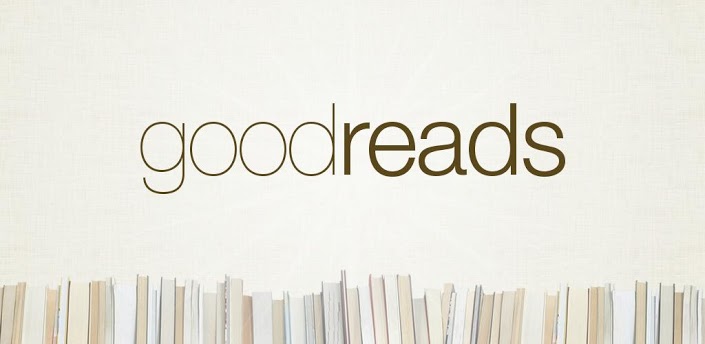
by Ben Zackheim | Mar 26, 2014 | Book Promotion, Writing |
Goodreads giveaways are a wonderful way for authors to reach potential readers. Why? Because when you give away your book on Goodreads, you’re placing all of your hard work in the hands of someone who wants your book and wants to enjoy it. That last part of the sentence is important. Everyone knows that Goodreads is filled with readers. But one of the unspoken benefits of Goodreads is that people on the site are predominantly kind and supportive. Yes, there are exceptions. But people want to enjoy the books they read. This means you’ll find readers and they’ll be on your side from the get-go.
When you give away a book it’s different than giving away an app, for instance. Books speak to our hearts, minds, senses, emotions. By giving away our story we’re already ahead of the mad rush for people’s hearts that other businesses strive for.
The second biggest benefit of Goodreads giveaways is powerful. If you’re giving away a pre-release book, Goodreads will email many of the contest entrants with news of your book launch. More on that below.
Before you can tackle any of the steps here, you’ll need to sign up to be a Goodreads Author.

This requires you to have a book in their system. You can add your book easily. Just make a simple request to a Goodreads Librarian.
So once you’re an author with work on the site, here’s how you set up Goodreads giveaways:
1) Go to www.goodreads.com and sign up or sign in
2) Click on Explore in the upper right. Then select “giveaways”.
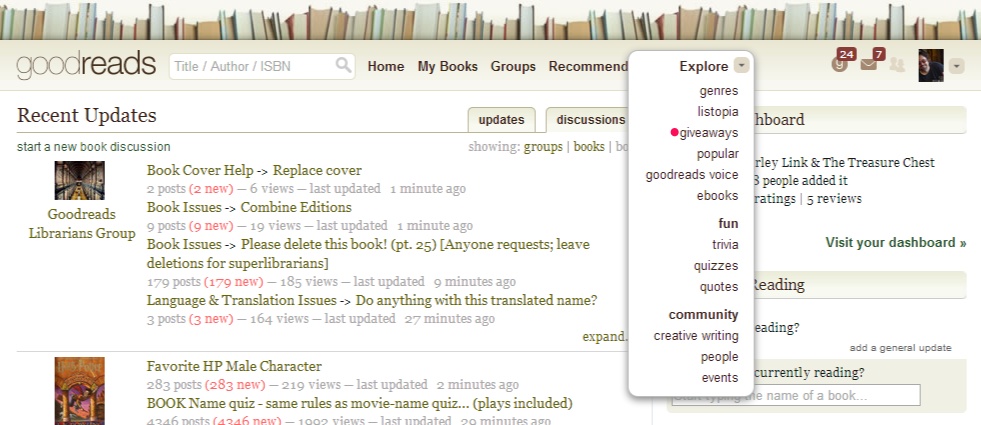
3) You’ll see a list of current giveaways. If you’ve signed up as a Goodreads Author you’ll see “List a Giveaway”. Select it.
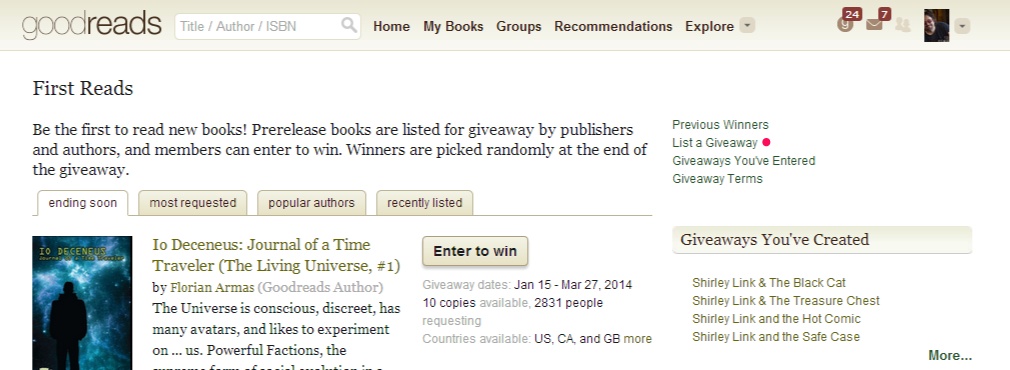
4) Here’s the listing page at last!
Look below the image to get the run-down.

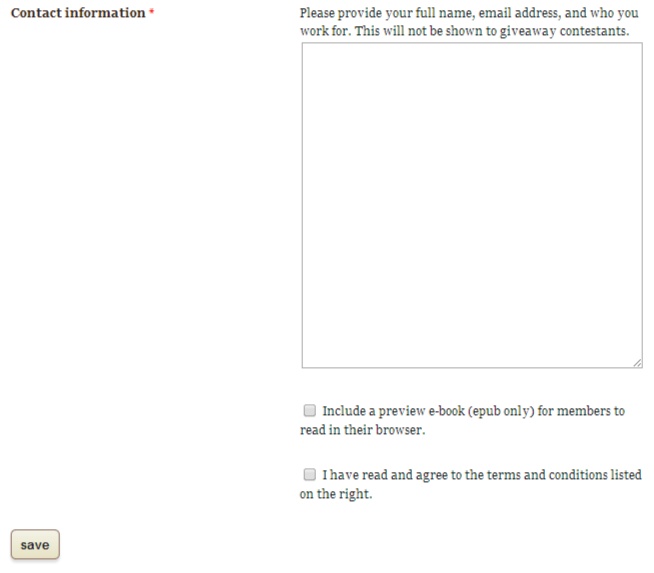
The “gotchas” and best practices are as follows:
-
Be sure to make the contest last a full month. Any less and you’re missing out on potential readers. In general, you’ll see the hugest spike in entrants as the contest deadline approaches, so fret not if things start slow!
-
Try to do the contest a full 2 months before the book launch. So when the contest ends you’ll still have a month to get feedback and reviews from your winners. And they’ll feel special that they got a book a month before it came out.
-
Enter your ISBN or ISBN13 in the field. If you only have an ASIN (Amazon’s ID format) then click on the “Switch to Book ID” link on the right side of the text entry field.
-
Make the description a kick-ass, direct pitch. The better the description, the more entrants you’ll get, guaranteed.
-
Goodreads likes to have authors give away 50 books. I agree that it’s a good number if you can afford it. I’ve done 10 and been happy with the results. However, I plan on following their advice with my next giveaway for The Camelot Kids. 50 copies, here I come!
-
If you don’t have a publisher then just enter your own site’s url. If you don’t have a site, please build one.
-
Choose the countries where you think your book will resonate. It’s a pain to send books internationally, but worth it if you can grow your global readership.
-
Tags are a whole post unto themselves. Enter terms that you believe apply to your book. You can use genre terms (horror, scifi), popular terms (Sherlock, Chicago Bears) or whatever comes to mind. The tags will help entrants choose the book that’s right for them.
-
The contact info is just asking you for basic info. Don’t worry about it. Just write something like “[Name], [email]. I’m the author of the book, [book name]
-
You can include an excerpt of your book for entrants to read. I’d advise doing this because the more people who enter who really WANT to win your book, the better your buzz will be.
Agree to the terms. They’re perfectly reasonable. Here they are for your convenience:
-
You agree to supply the indicated number of books on the date the giveaway ends.
-
Goodreads will list (for free) the giveaway book on the giveaways page.
-
Goodreads will collect interest in the book, and select winners at our discretion. Our algorithm uses member data to match interested members with each book.
-
After the giveaway stop date, click the name of your giveaway (listed under “your giveaways” on the main First Reads page) to see the list of winning addresses. You will also be emailed a list of winners. You are responsible for shipment of the books. Failure to do so will result in us not inviting you over for cake ever again.
-
You agree not to store the winners’ mailing addresses and not to use the winners’ addresses for anything other than sending them the indicated book.
-
Winning members are encouraged but not required to write a review of the book they receive.
-
Ebooks are not allowed. Every winner must receive a physical copy of the book.
Once you’ve started the contest you can retrace Steps 1-3. Notice the area on the right-hand side of the page that reads “Giveaways You’ve Created”? That will give you quick access. You can also find the contest listed on your Goodreads Dashboard
Now here’s the wonderful part. Everyone who enters your Goodreads giveaway will be opted-in to receive an email from Goodreads on the release date. That’s why they ask for the launch date of your book on the form above! In my experience about 75% of the entrants stay opted in.
That’s it! Now you need to promote the contest. That includes posting the Goodreads giveaway on linky (contest) sites and, yes, leveraging Goodreads advertising. I’ll post about that soon.
The final bit of usefulness comes from Goodreads itself. This slideshow is gold.
You might also find the following posts useful:
Does advertising on Goodreads work?
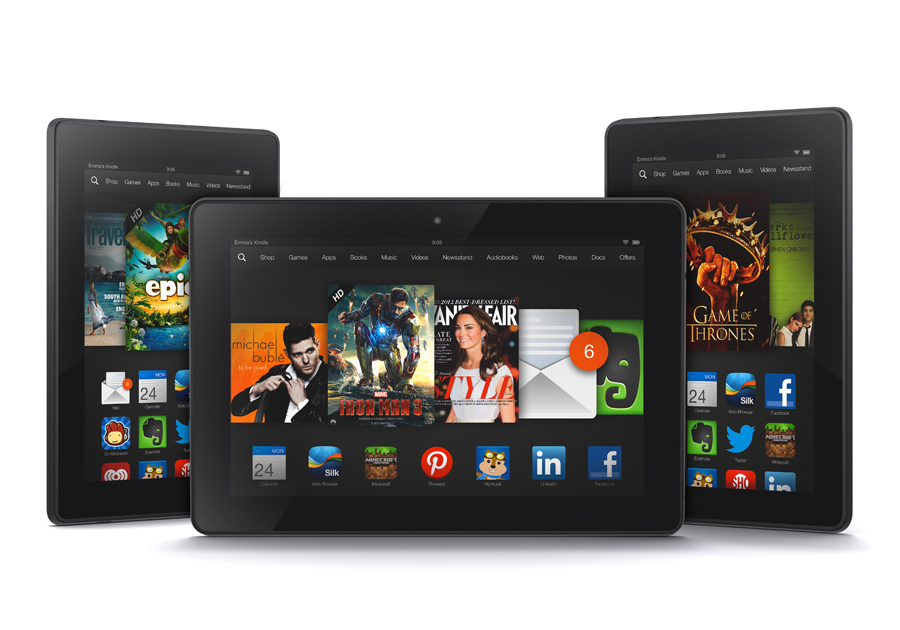
by Ben Zackheim | Jan 10, 2014 | Book Promotion, Writing |
If someone tells you, “I have a bridge to sell ya!”, would you believe them? Of course not!
But what if the mayor of New York City was the one talking? That makes it a tougher question. It’s conceivable that he could sell it to you. He’s the mayor! But wouldn’t he have to massage the bureaucratic engine of the city to make the sale happen? Isn’t he just one powerful person in a city of powerful people?
That’s the conundrum we find ourselves in with Amazon. They actually do have a bridge (to success) to sell us, and they could indeed sell it to us.
But will they do any of the hard work required to make the sale?
Does Amazon KDP work hard enough to justify your exclusivity?
As I mentioned in the last post in this series on KDP, there are over 20 million Amazon Prime members who can check out your book for free. Amazon has a big stake in showing those millions of people all of the amazing benefits they get for their $89 membership fee. One of those benefits is your KDP Select book! But to finish my point about the promotional possibilities, there’s just no way to tell when/where/whether your book will get a spotlight of any kind. Amazon has many ways to highlight books. Recommendations, newsletters, lists, you name it. But Amazon is also a long tail company, meaning they’ll only give real love to the top 20% of products in any category, leaving the 80% who don’t hit their proprietary criteria to fend for themselves.
It’s one thing to say you have the bridge, it’s quite another to say, I’ll walk you through the sale. Just like the mayor of New York doesn’t really know how to make the sale happen, Amazon can’t promise that KDP Select will be a bridge to success. But they want you to think it can.
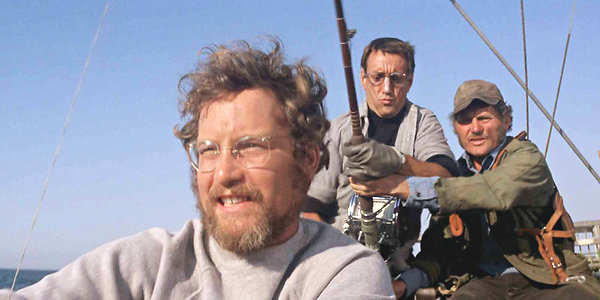
Remember that scene in Jaws, when the captain gets a peek at the shark for the first time?
“We’re gonna need a bigger boat,” he says, while watching the death of him swim away.
The way I see the bookselling world is as follows:
“We’re going to need a shorter list…”
If you think about it, we’re all on a bunch of lists.
Our names and our books are in the databases of businesses across the bookselling spectrum, from Amazon to Smashwords to Ingram. If you’re #457,098 on a popularity list, or a best-selling list, or a “best of” list then your visibility is — well, it is what it is.
Now, if your name and/or book is #412 then you’re much more visible! You’re more likely to show up in a newsletter, or to get reviewed, or to show up in a recommendation widget on some site somewhere, somehow.
In the same vein, to survive in the publishing world you need to be on a shorter list. I say do press releases, because it puts you on a shorter list. I say post your book to every site that allows it, because you’ll be on a shorter list. I say share as much free content as you’re comfortable sharing because you’ll be on a shorter list. My point is, if you’re not high on many lists then you need to be on a bunch of short lists.
So let’s say the unsayable here: The enticing promise of KDP Select is that Amazon will help your books get visible within their ecosystem. Anyone who says that Amazon doesn’t promise this is splitting hairs. Of course they don’t promise exposure. In the same way that Amazon splashes their $11 million+ Global Fund figure on KDP’s homepage in hopes of triggering your “lottery brain”, they want to plant the seed of hope that they’ll do some heavy lifting for you once you sign up — in the dark, behind the scenes, via newsletters or recommendations or pixie dust they will work their magic for you.
Guess what. They won’t strain anything.
Here’s what they will do to get your book seen:
1) They’ll allow 20 million+ Prime members to borrow your book (this is often worth as much or more cash than an actual sale)
2) They’ll give you five promotional days to give away your book for free. If done right (i.e. if you do a lot of work and spend money advertising) then you have a VERY good chance of showing up on Amazon’s semi-visible Top Free Books list. This is a tab that sits behind the best seller list on the genre pages. It’s getting harder to find as time goes on.
3) They’ll let you put your book on sale for a fixed amount of time using Countdown Deals. It’s a new feature, but there are some stories of success beginning to circulate. Amazon is big on good ol’ high-pressure sales tactics (see above for “I have a bridge to sell ya” and “Buy a raffle ticket and win big money!”) It looks like the tried-and-true method of limited-time sales also performs well.

Yes, sign up for KDP Select right away. Before it’s too late.
Here’s the thing that took me 2 years of playing the KDP Select game to learn. When Amazon takes a risk with you, you tend to come out on top. But like any business, when the risk stops paying off they’ll pull back in an instant. What that means for us is that Amazon likes releasing new services and features that are high-risk and beneficial to authors.
And then they’ll neuter it. Overnight.
An example?
KDP! What a huge shot in the dark it was for Amazon to open their market to small and self-publishers. Those who signed up early with quality work are the stars of our time. KDP best sellers and big movers got exposure, sitting right next to their big label counterparts, stealing eyes and hearts. While KDP authors are still given equal weight on the best seller lists, they’re relegated to a sorta-visible tab on genre pages. Yes, it qualifies as one of those “shorter lists”, but it’s more like a shorter, hidden list. The indisputable fact is that Amazon has pulled back their efforts to make KDP books visible on their site.
Need another example of Amazon taking risks and sharing the rewards, until they get tired of the risk?
The free promo days. Those free days were a huge risk that Amazon took with thousands of authors, and thousands of authors shared the rewards. But once Amazon grew the hell out of their library and snagged exclusivity on boat loads of books they dialed back their support of the promotional days. They did this by penalizing web sites who promoted the free books to readers. There are a lot of reasons why they did this, some of them ultimately good for our industry. But I’m not making a value judgment here. I’m just stating the fact that when Amazon tries something new (and we go along for the ride) then we tend to come out smelling rosey.
And that’s why I’m willing to say that, as of now, it’s worth signing up for KDP Select.
The Countdown Deals product is new. Amazon is taking a risk in launching it. With KDP they gave us a new market, with free promo days they gave us an effective way to be seen, and with Countdown Deals they’re giving us a dynamic way to sell.
From the Amazon description of Countdown Deals:
1) They’re time-based: Not only does this give you more control to decide how long the book is discounted, but the time remaining for the promotion is visible to customers to increase excitement for the price discount.
2) Customers see the regular price: It’s easy for customers to see the great deal they’re getting, as the regular price is included on the book’s detail page, right beside the promotional price.
3) Royalty rate is retained at lower prices: You will earn royalties based on your regular royalty rate and the promotional price. As a result, if you are using the 70% royalty option, you’ll earn 70% even if the price is below $2.99.
4) There’s a dedicated website: Customers can easily browse active; Kindle Countdown Deals at www.amazon.com/kindlecountdowndeals, providing yet another way for books to be discovered.
5) You can monitor performance in real-time: A new KDP report displays sales and royalties at each price discount side-by-side with pre-promotion performance, so it’s easy to compare.
Pay attention to #4. A dedicated Amazon site is a tremendous asset for authors. It means that the same avid readers that made free promos such a huge hit now have a place to browse great deals.
In the final analysis, the biggest benefit of joining KDP Select is the experience itself. You learn a lot. You experience how Amazon thinks. You sense its reach like never before. You spot opportunities in small corners of their world. For instance, by signing up for KDP Select I learned a whole bunch about how to leverage free promotional days to help sales. I use that knowledge with my non-KDP Select books, as well.
So give KDP Select a try with one of your books. If you don’t like it, opt out so you don’t auto-renew after 90 days.
What do you think? Do you think Countdown Deals are a seismic shift in the Amazon bookselling ecosystem? Or is it a bust-in-the-making for authors? Let us know in the comments!
In my next post, I’m going to break down, step-by-step, how I set up my free promotional days. This routine consistently gets me to the top 5 in both Young Teen Mysteries and Women Sleuths genres on Amazon.
by Ben Zackheim
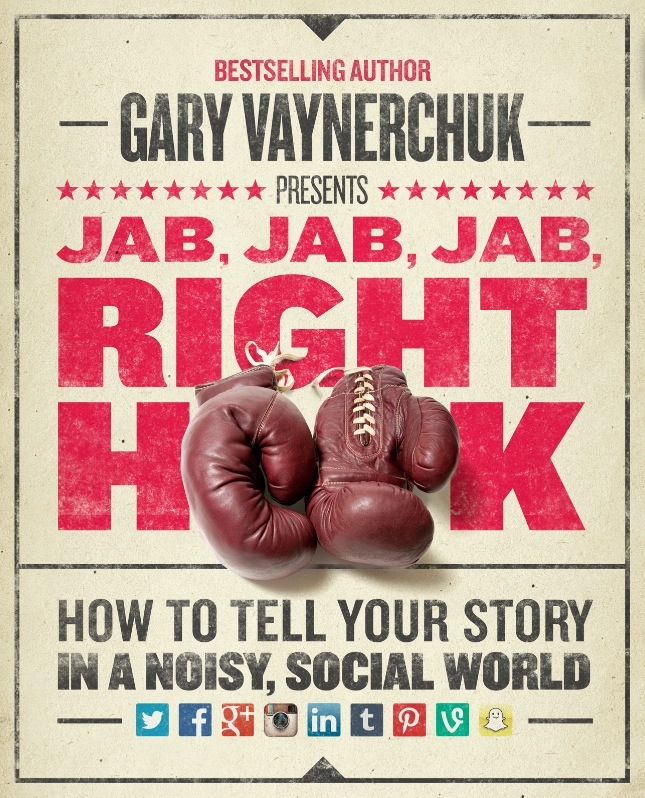
by Ben Zackheim | Dec 22, 2013 | Book Promotion, Writing |

I like to poke fun at social marketing, but I do respect those who can do it well.
I’ve been reading Jab, Jab, Jab, Right Hook by Gary Vaynerchuk. The premise of the book is that social marketing is like boxing, where you loosen up your target with jabs, then deliver a strong hook to close the proverbial deal. While he makes a lot of great points, my favorite advice covers the three characteristics of a great “right hook” social network post.
From his book:
1) They make the call to action simple, and easy to understand.
2) They are perfectly crafted for mobile, as well as all digital devices.
3) They respect the nuances of the social network for which you are making the content.
You’ll have to buy the book to dig into the meat of it, but he is onto something. I’ve found that a simple message always works best, especially if you know exactly who you’re trying to reach. It’s not new advice, but it’s tightly packaged in a list that I can put on a sticky note. Vaynerchuk also gives us his take on what exactly the nuances of each social network are, so the particulars of #3 are covered. Actually, the examples of good and bad social posts is the best part of the book. We get to see some hilarious near-misses, dead-on copy with complete photo failures, and so on.
You’ll close the cover with a new sense of what’s possible, which is what the author is going for. His frustration with how business is done is palpable throughout the tome. I get his irritation, having worked at Sony, Viacom and Aol over the years, it was rare that something nimble and new was crafted. Hopefully JJJRH will sit on the desks of managers throughout the mondoweb.
I recommend the book to anyone who’s ready to take social marketing seriously. One caveat (where I risk sounding stuck-up, but I’d rather sound stuck up than recommend a book that’s not a good fit!): The book is written clearly, but it does assume readers have struggled with the ins-and-outs and ups-and-downs of social marketing. If you’re new to this world then you’ll probably end up reading sentences a couple of times to get the gist. But when you do get it, you’ll be ahead of the game.
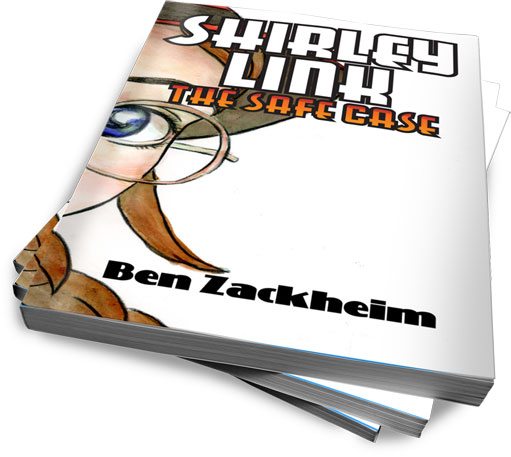
by Ben Zackheim | Feb 18, 2013 | Book Promotion, Writing |
This is a follow-up to a previous post.
I’ve received some feedback on my post about advertising on Goodreads, and it looks like some people are interested in getting into Goodreads, but haven’t made the plunge yet. This sequel is for you!
The thing I like about Goodreads is that it’s filled with readers of all ages. The best way to get to know people who share your tastes is search their groups. I’m still seeking out my niche, but I’ve found lots of helpful and supportive people by just making a page for myself .
If you’re an author you can either “claim” the books you’ve written, or you can upload your book data manually. Once you have an author page with books you can start to find friends by joining group discussions. The best way to sum it up is that Goodreads, while a bit obtuse, is a microcosm of all the reading/writing forums you’ve ever joined on the Web. It’s a wild west of discussions and contests and promotions. The benefit for the author is that you only interact with dedicated book lovers.
Goodreads started a service called Goodreads Self-serve Ads. You can buy, for up to 50 cents per click, ad space on the right or left column of some of their pages. The ads consist of a small image, ad copy and a link to wherever you want. You can set aside any amount as your budget (I chose 10 bucks) and you can track your ad’s performance.
The big benefit of ads on Goodreads is that everyone who sees the ad is more likely than the public at large to be interested in your ad. Still, to ensure you get the most bang for your buck Goodreads allows you to target your ad, meaning you can offer the ad to certain kinds of Goodreads customers. They allow you to show your ads ONLY to people who like (for instance) mystery and YA. You can choose as many genres as you’d like to target, but it’s a fine line you’ll walk in trying to target correctly.If you target too broadly you risk getting people clicking on your ad who are not interested in your kind of book. That’s wasted money. Conversely, if you target too specifically you can filter out perfectly good customers and not see anyone click on your ad at all.
You can also target customers by the author they like, which is an interesting filter that I plan to test out in my next campaign. I need to find out from my current readers who they think I’m similar to!
Advertising on Goodreads
As you can see in the image below, I set my daily budget to 2 bucks. That meant I was planning to pay for a max of 4 clicks on my ad (they charge up to 50 cents per click). I set 10 bucks as the campaign budget, meaning I planned on eventually paying for 20 clicks at 50 cents each. As you can see from the views data, a lot of people had the ad put in front of their faces. A “view” is simply defined as “your ad showed up on the person’s web page”. Goodreads can’t actually guarantee that someone saw and read the ad, they can only tell me that 116,129 people had the ad served to a page that they loaded. Of those 116, 129 Goodreads people, 20 people clicked on my ad. That is .02%

While that sounds miserable, it’s a middling result. A super success would be half a percent point considering that Goodreads doesn’t give you a sexy place on their page to put your ad. In the final analysis I got some exposure for my book series brand, and 20 people showed interest in buying the books.
Lessons learned
And here is where I learned my biggest lesson. Because I don’t have a sale page on my personal website where I can track traffic, I can’t see how many people actually bought the books. I can look at the dates when the ads ran and guess but that’s not a good way to measure these things. My conclusion is that it’s best to have a page with a shopping cart on your own site so you can check the traffic for your site and see “oh, he came from Goodreads.com and he bought a copy on my site.” This way you can see how successful the ad campaign is AND tweak your ad and/or purchase experience next time around.
I’ve learned about a trick and I plan to use it on my next book. According to Tom Corson-Knowles, you can track conversion on Amazon pages by placing an image of yourself in your book description. The image should be hosted by you and served from a bit.ly url. The bit.ly url will allow you to go to the bit.ly site and check traffic for the link. This way you can find out a bunch of user data on who went to your Amazon book page from Goodreads. I haven’t tried this on my Amazon profile because I use Amazon’s Author Central, which does not allow html in their profile form. However, if you are on KDP and have not signed up for Author Central, you CAN use the KDP profile form to enter html, including the bit.ly link. There are some tricks to it and I advise that you buy the three dollar book on Amazon, or borrow it if you’re on Amazon Prime. It’s worth it. It appears that Amazon has changed their policy. I tried to use this trick on a new book using KDP and my html was rejected. As of now, I’m not aware of a way to see traffic to your Amazon page.
Goodreads, for their part, advises ad buyers to make their ads link to the book’s Goodreads page. The Goodreads customer likes their ads to stay within the Goodreads ecosystem because they’re loyal and enjoy the experience.
I saw an uptick in my ads’ performance (known as CTR, or “click through rate”) when I did two things:
- Updated the copy. I went for the soft sell, instead of the hard sell. I toned down the language and removed the “Get the book for Xmas”-type wording. The hard sell doesn’t work well on Goodreads.
- I changed the ad so it linked to Goodreads instead of Amazon. This made the link at the bottom of the ad read “Goodreads” instead of “Amazon” which, again, appears to be what Goodreads customers prefer.
I hope this post now makes it clear what the benefits of Goodreads is as a platform and as a place to advertise.
by Ben Zackheim

by Ben Zackheim | Feb 11, 2013 | Book Promotion, Writing |
Does advertising on Goodreads work? My first step into their self-serve ad system shows promise. I know there’s interest in the writing community about advertising on Goodreads, so I thought I’d share the results of my first (ten bucks!) campaign.
I advertised two middle grade books in my Shirley Link series. The campaign started 12-6-2012.
While I’m somewhat pleased with the overall views, I can’t measure the actual sales since Amazon and BN.com are black boxes. I plan on making my own landing page for sales so I can measure conversion next time! Sigh. I knew that, but I didn’t account for it. No soup for me!
I targeted one ad using genres and authors as filters. I used no targeting for the other ad. The ctr was higher for the targeted ad (.01 vs. .02).
daily cap $2.00
total credit purchased $10.00 transactions
total views 116,129
total clicks 20
ctr for all time 0.02%
cpc for all time $0.50
The ten bucks started to go quickly, but after a couple of days it dropped to a trickle. I probably wouldn’t have spent the whole ten bucks if I hadn’t redone the creative on one book, including copy. I also adjusted the link for the ad and made it point to my Goodreads page, and not to my books’ Amazon pages. That simple move seems to have pushed it over the top and my ten bucks quickly got spent. Another benefit of linking to Goodreads page is that I saw a spike in my books being added to Goodreads shelves. It implies that the Goodreads community likes to stay on the site. It also implies (though I have no proof) that Goodreads gives preferential treatment to ads that link to their book pages, and not someone else’s.
[divider divider_type=”gradient”][/divider]
[blockquote author_name=”” width=”50%” float=”left”]My goals for next campaign:
Get a full half percent ctr (you read that right! .5, not .05!)
Track my custom sales page![/blockquote]
[blockquote author_name=”” width=”50%” float=”left”]Lessons learned:
Make a product/landing page that you can track!
Target the ad, but not too strictly. Limiting it to a few genres and several authors is a good place to start.
Adjust the ad when the views drop. Change the copy and graphic, if possible.
For first-timers/dabblers advertising on Goodreads: If you don’t have a landing page of your own where you can sell the book directly, then point the ad to your Goodreads page, NOT an online retailer. Since it’s probably really attractive to link to the online retailers (just to see what happens) I’d wait to do it on your second campaign. That way you can spot your own ad’s performance and adjust around the most important part…the conversion![/blockquote]













